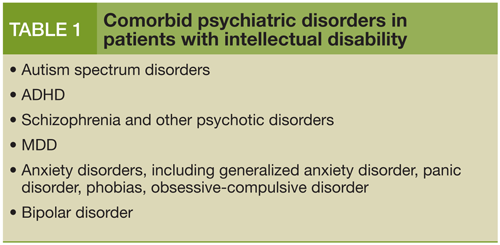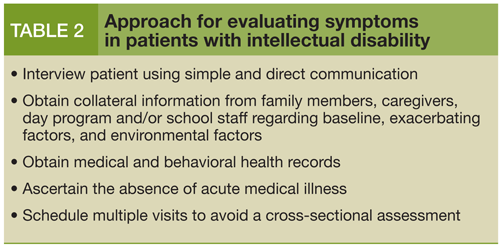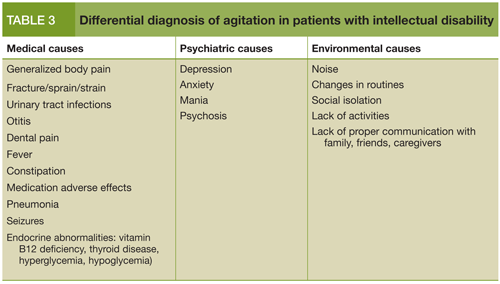Publication
Article
Psychiatric Times
Issues in Treating Patients With Intellectual Disabilities
Author(s):
Psychiatric disorders in persons with intellectual disabilities are typically more severe and more difficult to diagnose than in the general population. Clearly, those who diagnose ID and treat patients with this condition face a number of challenges.
Table 1: Comorbid psychiatric disorders in patients with intellectual disability

Table 2: Approach for evaluating symptoms in patients with intellectual disability

Table 3: Differential diagnosis of agitation in patients with intellectual disability

Intellectual disability (ID) is the term used to define a developmental disorder characterized by both intellectual and adaptive functioning deficits. This term has replaced “mental retardation” in DSM-5, which was spearheaded by the renaming of organizations such as the President’s Committee for People With Intellectual Disabilities in 2003 and the American Association on Intellectual and Developmental Disabilities in 2006. This terminology shift presents a welcome change from the negative perception of mental retardation in the general population and the medical community. In fact, the American Medical Association has instituted a policy to support the classification of individuals with ID as a medically underserved population. Also, the Commission to End Health Care Disparities expanded the scope of the commission to include persons with ID.
The prevalence of psychiatric disorders is higher in patients with ID. And psychiatric disorders in this population are typically more severe and more difficult to diagnose than in the general population; the degree of disability varies greatly. In the past 25 years, care has shifted from state hospitals to the community setting, thus increasing the need for medical and psychiatric care in the community. However, adequate services are typically lacking and the specific training of medical and psychiatric professionals is often insufficient. This has created additional barriers to proper intervention and treatment. In a survey by Werner and colleagues,1 90.2% of psychiatrists felt they lacked specific training in treating and diagnosing problems in the ID population.
What new information does this article provide?
The purpose of this article is to increase awareness of the varied and atypical presentations of patients with intellectual disabilities and comorbid psychiatric illnesses. Novel approaches to behavioral therapy and environmental modifications, and a review of pharmacotherapeutic options are discussed.
What are the implications for psychiatric practice?
The aim of this article is to assist practitioners by providing tips for diagnosing and treating patients with intellectual disabilities and comorbid mental illness. Relevant cases are provided to highlight the inherent complexities of this underserved community and to give insight to clinicians regarding multimodal treatment options.
Prevalence of psychiatric problems
The prevalence of psychiatric disorders in individuals with ID is estimated to be between 32% and 40% (Table 1).2 Psychiatric disorders are more easily diagnosed in patients with mild to moderate ID than in those with severe ID.
The prevalence of autism spectrum disorders in individuals with mild ID is 5% to 10%, and in those with moderate to severe ID, up to 30%.3 The prevalence of ADHD in children with ID is estimated to be between 8.7% and 16%, compared with 5% in the general population.4 The prevalence of MDD has been reported to be 1.5- to 2-fold higher than that in the general population, while rates of both schizophrenia and bipolar disorder have been estimated at twice that in the general population.3 High rates of anxiety disorders have also been reported in this population, particularly in those with comorbid autism with symptoms of phobias, stereotypies, and compulsions.5
Challenging behaviors (ie, aggression toward others; self-injurious behavior; inappropriate social and sexual behavior; and selfstimulating behavior, such as rocking, withdrawal, or noncompliance) are 3 to 5 times more common in the ID population.6 About 12% to 46% of individuals who have ID receive psychotropics for such behavioral problems. Rates are higher among adults and those living in institutions.4
Findings suggest that certain behavioral problems are associated with specific psychiatric diagnoses.7 Anxiety has been correlated with tantrums, mania with tantrums, aggression, and screaming; depression has been correlated with aggression, tantrums, and screaming in severe/profound ID and with tantrums and self-injury in mild to moderate ID.
Challenges in correct diagnoses
Clearly, individuals with ID have high rates of psychiatric comorbidities. However, diagnostic difficulties due to atypical presentations, diagnostic limitations secondary to communication barriers, and lack of formal diagnostic tools are inherent in this population. Studies show that the diagnosis of psychiatric disorders in the ID population is affected by language skills and the severity of ID.6,7
Atypical presentations for psychiatric conditions in the ID population are common. Psychiatric symptoms may manifest as agitation, aggression, withdrawal, changes in sleep or appetite, and self-talk that is distinct in content. Most psychiatrists are comfortable in evaluating a patient on the basis of direct history and obtaining collateral information from family members. In patients with ID, collateral information from caregivers is even more important.
History taking in nonverbal patients or those with limited language skills is accomplished by using simple, direct, easy to understand language and by understanding the patient’s baseline behavior so that aberrancies are detected. Triggers and behavioral patterns, such as reactions to boredom and noise or verbalizations of normal emotions, are characterized with the assistance of primary caregivers and/or staff members who are familiar with the patient.6 This can be challenging and might require multiple visits and a substantial investment of time (Table 2).
CASE VIGNETTE
Mr A is a 35-year-old with moderate ID and atypical symptoms of bipolar disorder that required consultation with the treatment team and family to establish a correct diagnosis. He is also autistic, with expressive and receptive language delay and multiple medical problems: type 2 diabetes mellitus, chronic constipation, sleep apnea, recurrent urinary tract infections, allergic rhinitis, and hypertension. Clinical symptoms include mood swings, impulsivity, self-injurious behavior, paranoia, and obsessive-compulsive behaviors.
Mr A is unable to verbalize symp-toms adequately, so observation is important: depression manifests as withdrawal, decreased appetite, and weight loss; screaming and unexplained laughing are signs of mood swings; paranoia manifests as fearfulness; and repetitive behaviors are seen as obses-sive compulsiveness.
Agitation and self-injurious behaviors increase during medical exacerbations or complications.
After a careful history is taken and he is examined, medical problems are addressed. This is followed by a team meeting, during which a behavioral analysis is done and appropriate environmental modifications are made. Sensory integration therapy, music therapy, greenhouse volunteering, positive reinforcement, and frequent redirection are used, and medications are adjusted.
It is also important to screen for physical causes of anomalous behavior, including unrecognized pain (eg, reflux, otitis, urinary tract infections, dental pain, fractures, constipation), endocrine causes, adverse effects of medication, and seizures (Table 3). Environmental issues and changes must be considered, including the level of environmental stimulation, social isolation, inconsistent communications, and excessively demanding expectations on the part of the caregivers.
CASE VIGNETTE
Ms X is a nonverbal 25-year-old with profound ID with impulse control disorder and self-injurious behavior. She also has numerous medical problems: cerebral palsy, spastic diplegia, osteoporosis, seizure disorder, recurrent urinary tract and ear infections, chronic constipation, a dysfunctional urinary bladder, and allergic rhinitis. She frequently becomes agitated.
Since she has multiple medical problems, the first step is to look for recurrence of infection. An ear infection or worsening constipation usually presents with agitation in a nonverbal patient. A very careful history that includes details of bowel movements helps correctly identify the cause of agitation.
She is on a regimen of stool softeners, long-term antibiotics, and antihistamines for allergies. She responds very well to behavioral interventions (such as sensory integration therapy, applied behavioral analysis for self-injurious behaviors and agitation), music and water therapy, sign language, picture communication blocks, and deep massage. A low dose of a benzodiazepine is used as needed for intermittent agitation. Atypical antipsychotics and mood stabilizers can also be used as needed for impulsivity associated with self-injurious behaviors.
To compound these diagnostic barriers, studies have found that physicians do not feel adequately prepared by their medical education to treat patients with ID, which leads to a lack of confidence.8,9 Studies have also shown that psychiatrists, who predominantly provide diagnoses and treatment, feel inadequately prepared to manage patients with ID and comorbid psychiatric problems.1 Because the prevalence of psychiatric problems is higher in patients with ID than in the general population, it is critical that psychiatrists obtain more specialized training. There has been a growing appreciation of the issues at all levels of training in medical schools and psychiatry residencies, with a focus on curriculum development that addresses diagnosing and treating ID.
Treatment and management
Correctly identifying the cause of behavioral problems and addressing medical problems is the first step in the management of patients with ID. Once an accurate diagnosis of comorbid psychiatric problems has been made, a multimodal approach to treatment is used. Initially, a behavioral analysis is done and behavior modification techniques suitable to each patient are implemented alone or in combination with pharmacotherapy. Interventions include massage therapy, water and music therapy, sign and picture communication training, and volunteering.
In addition, modifications of the home environment can be implemented, including reducing overstimulation and noise, providing activities and opportunities to engage with others, teaching relatives and caregivers techniques for improving communication, and providing assistance to families. Useful behavioral techniques include setting boundaries, redirection, positive reinforcement of desired behaviors, noncontingent reinforcement procedures, activity schedules, and task correspondence training. Unfortunately, research on the efficacy of psychotherapy in this population is lacking. However, cognitive-behavioral therapy may be effective in reducing anger.10,11
Consider psychotropics only if therapeutic/social measures do not adequately address symptoms. General principles include targeting specific psychiatric symptoms, starting low and slowly titrating medication, weighing the risks of adverse effects and the benefits of pharmacotherapy, and judiciously using medications on an as-needed basis.
Risperidone has been shown to be effective for treatment of hyperactivity, irritability, impulsivity, aggression, and stereotypic behavior in children and adults.4 Risperidone therapy should be balanced against adverse effects, such as hyperprolactinemia, weight gain, somnolence, headaches, metabolic derangements, risk for type 2 diabetes mellitus, and extrapyramidal symptoms, which are dose-dependent. Dosages of 2 to 4 mg/d have been shown to be effective.
Quetiapine can be effective for the treatment of aggressive and hyperactive behavior. Its adverse effects include sedation, weight gain, and paradoxical agitation.4
Olanzapine has been shown to be effective for hyperactivity and irritability at dosages between 10 and 20 mg/d.4 However, because of the increased risk of sedation, weight gain, and hyperlipidemia in the adolescent population and more adverse effects than with risperidone, it is not recommended as first-line treatment.
Ziprasidone has been shown to be efficacious in reducing aggression and irritability in pervasive developmental disorders.4 It is not associated with weight gain and metabolic symptoms, but because it promotes a prolonged QT interval, caution must be used.
Because of adverse effects that include agranulocytosis, excessive salivation, weight gain, orthostatic hypotension, hyperthermia, and risk of seizures and type 2 diabetes mellitus, clozapine is not recommended for disruptive behavior only.4 It can be used for treatment-resistant schizophrenia, with careful observation for emergence of adverse effects.
Stimulants and nonstimulant atomoxetine have shown efficacy for comorbid ADHD, but only in patients with an IQ above 50.4 Because of decreased efficacy and increased adverse effects, including tics, social withdrawal, irritability, anxiety, and anorexia, stimulants are not recommended in persons with an IQ less than 50. Paradoxically, hyperactivity, attention deficits, and impulsivity may increase if stimulants are given to patients with ID without comorbid ADHD.
SSRIs have been shown to be efficacious in treating stereotypic and self-injurious behaviors. In particular, fluoxetine shows a positive effect in children with ID.4
Mood stabilizers, such as lithium, valproic acid, carbamazepine, oxcarbazepine, were shown to be efficacious in the treatment of impulsivity, bipolar disorder, and aggression.4 Valproic acid is recommended as the treatment of choice for aggression and self-injurious behavior in children. However, because valproic acid has been associated with hepatic failure, pancreatitis, thrombocytopenia, development of ovarian cysts, obesity, irregular menses, increased hair growth, sedation, GI upset, tremor, and alopecia, its utility is reduced. Lithium is not recommended for disruptive behavior, because of the increased risk of weight gain, hypothyroidism, tremor, polydipsia, polyuria, diabetes insipidus, acne, ECG changes, muscle weakness, and intoxications.
Naltrexone has been shown to be effective for acute treatment of hyperactive, impulsive, stereotypic, and aggressive behavior.4 In addition, α-agonists, such as clonidine and guanfacine, have been used off-label for concomitant ADHD.
If behavioral problems can be predicted in certain settings, such as doctor visits or mandatory blood draws, judicious use of as-needed medications, particularly benzodiazepines, may be warranted, with caution for respiratory depression, addictive potential, and paradoxical agitation.6
Finally, providing appropriate care for ID patients includes addressing family and caregiver needs. Additional services available to families of patients with difficult to manage behavior include group and residential homes and the use of case management and assertive community treatments.
Conclusion
Clearly, those who diagnose ID and treat patients with this condition face a number of challenges. The lack of specific and specialized training for providers is accompanied by stigma regarding patients with ID. Even physicians reported biases related to this population, including anxiety and intimidation when providing primary care, negative attitudes, and use of pejorative terminology.8,12,13 Physicians also reported a lack of knowledge about community resources, which are unfortunately deficient for ID patients with and without comorbid mental illness.14 This highlights not only the need for more education for physicians but also the importance of advocacy for available services to improve the quality of care for patients with ID.
Disclosures:
Dr Aggarwal is an Assistant Professor in the department of psychiatry at Rutgers New Jersey Medical School, Newark. Dr Guanci is PGY-4 Resident in the department of psychiatry at Rutgers New Jersey Medical School. Dr Appareddy is Immediate Past Chair of the AMA IMG Governing Council and Vice Chair of the President’s Committee for People With Intellectual Disabilities (2002-2006). They report no conflicts of interest concerning the subject matter of this article.
References:
1. Werner S, Stawski M, Polakiewicz Y, Levav I. Psychiatrists’ knowledge, training and attitudes regarding the care of individuals with intellectual disability. J Intellect Disabil Res. 2012 Sep 14; [Epub ahead of print].
2. Bhaumik S, Tyrer FC, McGrother C, Ganghadaran SK. Psychiatric service use and psychiatric disorders in adults with intellectual disability. J Intellect Disabil Res. 2008;52:986-995.
3. O’Brien G. Dual diagnosis in offenders with intellectual disability: setting research priorities: a review of research findings concerning psychiatric disorder (excluding personality disorder) among offenders with intellectual disability. J Intellect Disabil Res. 2002;46(suppl 1):21-30.
4. Hässler F, Reis O. Pharmacotherapy of disruptive behavior in mentally retarded subjects: a review of the current literature. Dev Disabil Res Rev. 2010;16:265-272.
5. Bradley EA, Ames CS, Bolton PF. Psychiatric conditions and behavioural problems in adolescents with intellectual disabilities: correlates with autism. Can J Psychiatry. 2011;56:102-109.
6. Woods R. Behavioural concerns-assessment and management of people with intellectual disability. Aust Fam Physician. 2011;40:198-200.
7. Myrbakk E, von Tetzchner S. Psychiatric disorders and behavior problems in people with intellectual disability. Res Dev Disabil. 2008;29:316-332.
8. Wilkinson J, Dreyfus D, Cerreto M, Bokhour B. “Sometimes I feel overwhelmed”: educational needs of family physicians caring for people with intellectual disability. Intellect Dev Disabil. 2012;50:243-250.
9. Peter NG, Forke CM, Ginsburg KR, Schwarz DF. Transition from pediatric to adult care: internists’ perspectives. Pediatrics. 2009;123:417-423.
10. Oliver C, Richards C. Self-injurious behavior in people with intellectual disability. Curr Opin Psychiatry. 2010;23:412-416.
11. Nicoll M, Beail N, Saxon D. Cognitive behavioural treatment for anger in adults with intellectual disabilities: a systematic review and meta-analysis. J Appl Res Intellect Disabil. 2013;26:47-62.
12. Bouras N, Holt G. Mental health services for adults with learning disabilities. Br J Psychiatry. 2004;184:291-292.
13. Walker J, Scior K. Tackling stigma associated with intellectual disability among the general public: a study of two indirect contact interventions. Res Dev Disabil. 2013;34:2200-2210.
14. Kroese BS, Rose J, Heer K, O’Brien A. Mental health services for adults with intellectual disabilities-what do service users and staff think of them? J Appl Res Intellect Disabil. 2013;26:3-13.






